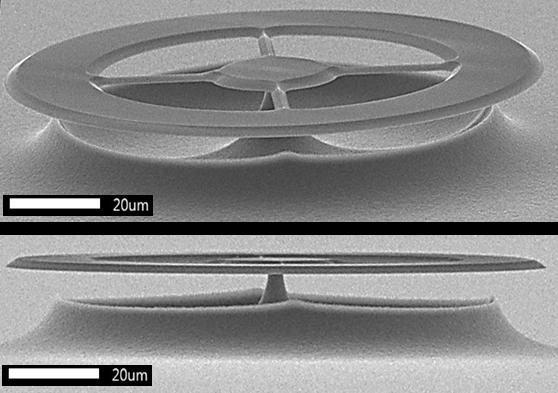Ultra ultrasound to transform new tech

Image of ultrasound sensor. Credit: University of Queensland
The new sensor – capable of detecting vibrations of living cells – may revolutionise everything from medical devices to unmanned vehicles.
World first experiments at the University of Queensland have combined modern nanofabrication and nanophotonics techniques to build the first ultraprecise ultrasound sensors on a silicon chip.
According to lead author Dr Sahar Basiri-Esfahani, a Sêr Cymru II Fellow at Swansea University, the impressive accuracy of the technology may change how we understand biology.
“We'll soon have the ability to listen to the sound emitted by living bacteria and cells,” she said.
“This is a particularly attractive application, as it could fundamentally improve our understanding of how these small biological systems function,” “And a deeper understanding of these biological systems may lead to new treatments, so we're looking forward to seeing what future applications emerge.” Dr Basiri-Esfahani said.
Professor Warwick Bowen, from UQ's Precision Sensing Initiative and the Australian Centre for Engineered Quantum Systems said that the leap forward may usher in a host of exciting new technologies. “This is a major step forward, since accurate ultrasound measurement is critical for a range of applications,” he said.
“Ultrasound is currently used for medical ultrasound, commonly to examine pregnant women, as well as for high resolution biomedical imaging to detect tumours and other anomalies.
“It's also commonly used for spatial applications, like in the sonar imaging of underwater objects or in the navigation of unmanned aerial vehicles. “Improving these applications requires smaller higher precision sensors, and with this new technique, that's exactly what we've been able to develop.”
The new ultrasound-sensing technology, for the first time, reaches the regime where its noise is dominated by the random miniscule forces from surrounding air molecules.
“We've developed a near perfect ultrasound detector, hitting the limits of what the technology is actually capable of achieving,” Professor Bowen said.
“We're now able to measure ultrasound waves that apply tiny forces – comparable to the gravitational force on a virus – and we can do this with sensors smaller than a millimetre across.”
###
The research was supported by the Australian Research Council, the European Union's Horizon 2020 research and innovation programme (Marie Skłodowska-Curie Actions COFUND), the Welsh Government through the European Regional Development Fund (Sêr Cymru Programme), and the United States Air Force Office of Scientific Research.
Media Contact
All latest news from the category: Physics and Astronomy
This area deals with the fundamental laws and building blocks of nature and how they interact, the properties and the behavior of matter, and research into space and time and their structures.
innovations-report provides in-depth reports and articles on subjects such as astrophysics, laser technologies, nuclear, quantum, particle and solid-state physics, nanotechnologies, planetary research and findings (Mars, Venus) and developments related to the Hubble Telescope.
Newest articles

Microscopic basis of a new form of quantum magnetism
Not all magnets are the same. When we think of magnetism, we often think of magnets that stick to a refrigerator’s door. For these types of magnets, the electronic interactions…

An epigenome editing toolkit to dissect the mechanisms of gene regulation
A study from the Hackett group at EMBL Rome led to the development of a powerful epigenetic editing technology, which unlocks the ability to precisely program chromatin modifications. Understanding how…

NASA selects UF mission to better track the Earth’s water and ice
NASA has selected a team of University of Florida aerospace engineers to pursue a groundbreaking $12 million mission aimed at improving the way we track changes in Earth’s structures, such…





















